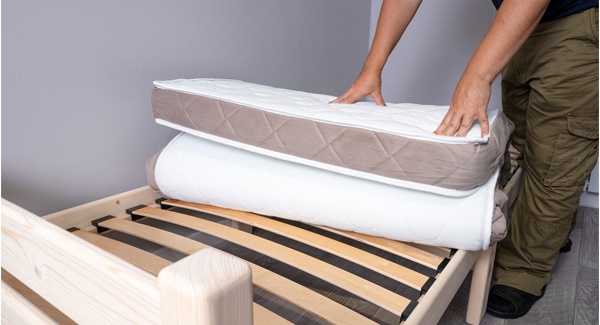Home » Pillow advice » Pillow Talk: How Many Pillows Should You Sleep With?
How many pillows should you sleep with?
Article navigation
- Published:
- Written by: Tony Brown
- Topic: Pillow advice
Pillows are an essential part of our sleep routine. A good pillow should support the head and neck, relax the muscles, and keep the spine correctly aligned during sleep.
There’s no definitive answer regarding how many pillows you should sleep with. The consensus is that you should initially sleep with one pillow. However, other factors should be considered, such as body shape, pillow design and your preferred sleeping position.
Whether you sleep on one or more pillows often comes down to personal preference. But, pillow height can affect comfort and sleep quality, so choosing the right number of pillows is essential.
Piling pillows on top of each other because they might be too soft or unsupportive is a common mistake people make. Sleeping on too many can cause the spine to bend forwards. Another problem with stacking pillows is that we move around during the night, and pillows may end up on the floor or away from your head.
In comparison, sleeping on a low pillow or not using one can cause the spine to stretch backwards.
If you’re unsure whether your pillow supports you correctly, ask someone to check if your head, neck, and mid-upper back are in a straight line. Alternatively, you could use your phone or camera to take a picture of yourself lying down.
Preferred sleeping position
Your preferred sleeping position can affect how many pillows you sleep with. Most people tend to sleep on their side or their back. However, sleeping posture changes throughout the night.
Side sleepers typically require a pillow that fills the gap between the ear and shoulder. One pillow should be sufficient, but if you’re finding this uncomfortable, you could use extra pillows providing they don’t tilt the head into an unnatural position.
Correct pillow height or loft varies from person to person. Someone with broader shoulders may find a thicker pillow more supportive, whereas someone with narrow shoulders may prefer a thinner pillow.
For back sleepers, again, one pillow should suffice. Back sleepers typically want to avoid a thicker pillow that will prop their neck up and cause misalignment.
Side and back sleepers may also benefit from placing an extra pillow under the knees to relieve pressure and improve alignment.
Some people prefer to sleep on their front. However, sleeping in this position puts significant strain on the neck muscles. Stomach sleepers should avoid using a firm pillow, as it can put the head and neck at an uncomfortable angle.
If you prefer sleeping on your stomach, try sleeping with a softer, thinner pillow. If you find this uncomfortable, you could sleep without a pillow, but ideally, the head and neck need to be supported. Sleeping without a pillow may also help to relieve some of the stress on the neck and lower back, but this is not recommended for other sleeping positions.
Pillow firmness
It is also important that pillows have the right softness or firmness. Choosing pillow firmness comes down to personal preference, but you should also consider your preferred sleeping position.
Side sleepers may benefit from a medium to firm pillow to bridge the gap between the ear and the shoulder. Back and side sleepers may find a softer, thinner pillow more suitable.
Also, keep in mind that softer pillows compress more, affecting pillow height. So you may need to use an extra pillow to compensate for the height loss after compression.
Pillow shape and material
As well as considering how many pillows to sleep with, you should also consider pillow design. Pillows come in various shapes and materials. A well-designed pillow can help maintain the spine in a neutral position and improve sleep quality.
Traditional rectangular pillows are widely used. Other people prefer a neck support pillow designed to relieve neck pain.
Memory foam and latex are among the most popular types of pillows. Both provide good head and neck support and are effective at relieving pressure.
Sleeping without a pillow
Sleeping without a pillow could cause poor sleep posture resulting in neck and back pain, and should be avoided where possible. However, stomach sleepers require minimal head support and may prefer sleeping without a pillow.
Final thoughts
It helps to try out pillows before you buy them where possible. Comfort is subjective. What’s comfortable for one person may not be for someone else. Furthermore, some retailers may not accept the return of pillows for hygiene reasons, so trying out pillows beforehand will help you choose the right ones.
Like a new pair of shoes, it can take time to adjust to a new pillow. But with regular use, it should start to perform as expected.
Finally, as pillows affect your sleeping posture, come into close contact with the skin, and lose their shape relatively quickly, it’s often a good idea to invest in new pillows every two to four years.
Share this article

About the author
Tony Brown is the founder and creator of The Bed Consultant. His career in the bed industry began in 2002. After graduating from university with a degree in Business Administration, Tony joined one of the largest independent furniture retailers in the UK as a bed consultant. Tony has helped thousands of customers find the perfect mattress.





